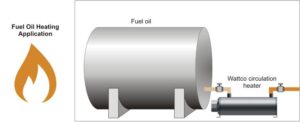Circulation Heaters for Oil Heating Application
Circulation heaters are used extensively in industrial process heating. They are known to transfer heat to a flowing medium such as oil. The heater’s main vessel is equipped with a heating element inside, a thermostat, and terminal boxes. It also has inlet and outlet nozzles for the entry and exit of the fluid, i.e., oil.
Please refer to Figure 1 for one application. Industrialists use circulation heating to pre-heat heavy oils (with high viscosity) for smooth pumping. Pre-heating also facilitates easy burning.
Example:
For oil with viscosity 900 seconds SSU (measured by a Saybolt Universal viscometer at 100 deg F)
Typical minimum temperature to pump: 60 to 80 degree F
Typical temperature for burning: 165 deg F
Although circulation heaters are efficient devices to raise the temperature of highly viscous materials, they are also used to keep a consistent temperature for light and medium-weight oils, along with its smooth flow characteristics.
Construction and operation of circulation heaters
Circulation heaters are sturdily constructed of metals such as steel, or stainless steel. The heater is insulated so no heat can escape. Circulation heaters usually consist of flanged immersion heaters.
For oil heating application, the user can choose a wide range of wattage (Refer to Table 2.), flange and sheath materials, vessel sizes, terminal boxes, and power (in kilowatts) ratings. .
|
Applications |
Sheath |
Flange |
|
Heating of (low, medium and heavy-weight) oils |
Steel |
Steel or Stainless Steel |
For proper heating, the oil should enter the circulation heater through the inlet nozzle which is near the flange immersion heater. Desired temperature is achieved when the oil circulates through the length of the vessel. The oil then leaves the heater through an exit nozzle.
There are two types of mounting for circulation heaters: horizontal and vertical. The vertical mounting is ideal if the space is limited.
One salient feature of circulation heaters is a valve for draining water. This valve can be installed anywhere in the vessel. It allows purging of oil, facilitating easy maintenance, when needed.
In circulation heaters, there are thermocouple probes or thermostats to control the oil temperature to the desired level and also for over-temperature protection. Thermocouples are mounted on the outlet nozzle for process control.
There are different types of terminal boxes for circulation heaters. In most cases, a basic terminal box is sufficient. The terminal boxes are also moisture resistant. With specialized terminal boxes, WATTCO circulation heaters are also approved for use in explosive environments.
Frequently Asked Questions
Q1: What is a Saybolt Universal viscometer?
A Saybolt Universal viscometer is an instrument to measure viscosity of any fluid. For example: a reading of 100 SSU at a specified temperature signifies that an oil sample will pass in 100 seconds through the viscometer at that temperature.
Q2: What role does sulfur play in fuel oils?
Although in small amounts, sulfur is present in heavier fuel (with higher viscosity). It burns with water vapor to produce sulfur oxides. Sulfur oxides are highly corrosive, in particular for metal chimneys.

